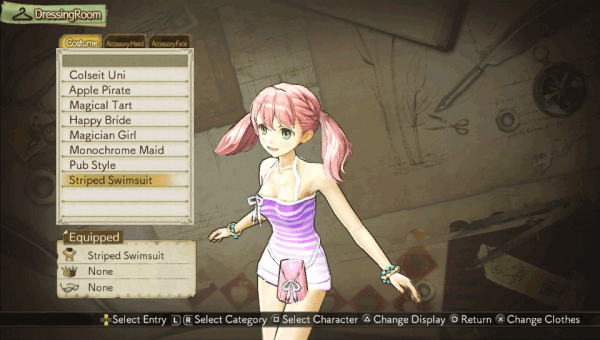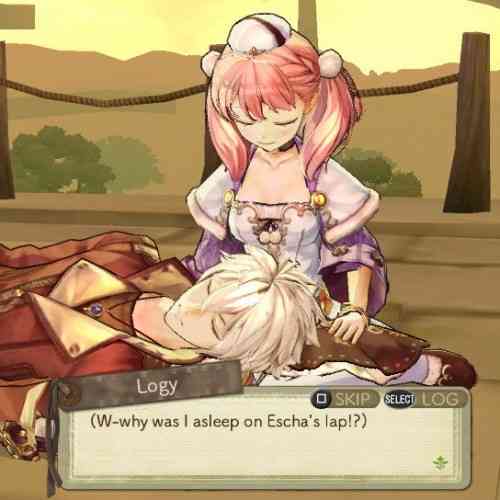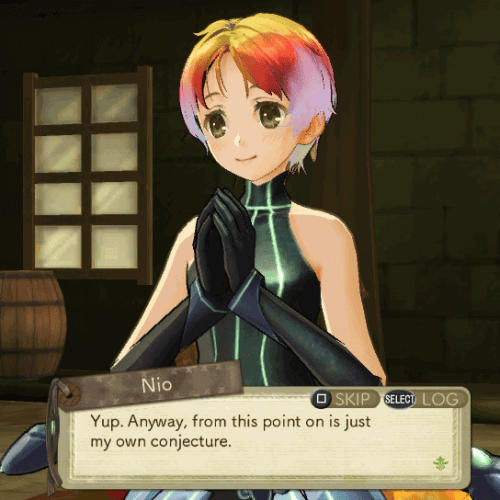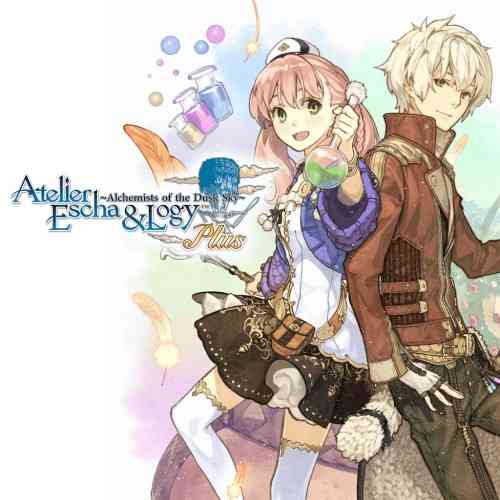The Atelier series has been alive and kicking since 1997 – that’s nearly twenty years! Although the first Atelier game to hit North American shores was in 2005, it’s evolved, grown, and morphed into a unique JRPG that not many know in comparison to other JRPGs. Back in March of 2015, I had a chance to review Atelier Shallie: Alchemists of the Dusk Sea (which you can check out here), the third installment in the Dusk series. It was the first Atelier game I actually got hands-on time with as I’ve previously only watched my sister play through them, and it was extremely enjoyable. The Dusk series, for those who are unaware, include Atelier Ayesha, Escha and Logy, and Shallie. So, going back an installment, Atelier Escha & Logy is the second iteration in the Dusk series and holds quite a high amount of importance for one big change – the choice of having two main characters to play and choose between. It was at Atelier Escha & Logy where the trend of two main protagonists began, as can be seen in Atelier Shallie and the upcoming Atelier Sophie. However, with its return in a “Plus” version for the PS Vita, we’ll be checking out some of the newly added content aside from what Atelier Escha & Logy Plus: Alchemists of the Dusk Sky has already offered on the PS3.
As stated above, there are two main protagonists to choose between and play as throughout the game, which you decide on from the get-go. These two characters are Escha and Logix (nicknamed Logy) who both partake in the development project in a town called “Corseit”. While Escha lives in Corseit, Logy came from a city named “Central”. Their upbringings and personalities are quite different, but is what aids them in the challenges they face as they complement each other better than you would expect. Don’t stress over who you choose as they are together almost a hundred percent of the time. But, depending on who you choose, you’ll experience different internal dialogues and thoughts from them and also progress through the game in a slightly different fashion.
The story progressively unfolds as you tirelessly work, read through dialogue, and did I mention work? Yes, there is quite a bit of dialogue as the Atelier games do, but I found this one to have quite a handful of fluff. Also, the story as a whole truly revolves around working on development projects and whatnot which can be quite a bore. I found the story this time around to be a bit too mellow and, at times, fruitless.
_______________________________
“All of the mechanics are recycled and utilized for the various tasks to be completed and characters to interact with. So, as long as you like the core mechanics of the game, it can keep you busy for days-on-end.”
Throughout the Atelier games, most of the mechanics are very uniform and only merely get touched up on with each new entry. The reoccurring mechanics include alchemy to synthesize items, harvesting through expeditions, and turn-based battles. All of the mechanics are recycled and utilized for the various tasks to be completed and characters to interact with. So, as long as you like the core mechanics of the game, it can keep you busy for days-on-end. As you’d expect, the mechanics are very much linked to one another with one mechanic leading to the next. As you strive to complete the various tasks, you’ll have to obtain certain items, get to certain areas, or fight/defeat certain things. These could take you anywhere from going to harvest items, using the harvested goods to synthesize the needed item through alchemy, or simply going on expeditions to battle the particular beast. Nevertheless, it really is a cycle and process that you’ll continuously commit to, but it sure keeps you trucking along through the game.
Akin to previous installments, the alchemy and battle mechanics can get quite rigorous and complex, but starts off extremely approachable as it gradually trains you to understand the additional complexities it has to offer. The game is full of tutorials that are clear and concise that really takes your hand and walks you through whatever you may be questioning. But, for the sake of a quick rundown, I’ll lightly touch upon the various elements in alchemy and battles.
Alchemy is used for synthesizing the various things obtained in the game whether it’s through harvesting from expeditions or purchasing them from a store vendor. Some items can only be obtained through synthesizing certain items, which usually are needed for tasks. Alchemy can also be used for armor or weapons which make certain items more effective than others. Depending on the item used, bonuses can be applied on the particular gear. So this is where the combinations are infinite as you can choose amongst the various item types to synthesize together to obtain your perfect item.
Battles are pretty straight forward as it’s all turn-based with the exception of some unique additions. Battles consist of your party of up to six characters with three in the front-lines and three in the back. While each character can take damage from an enemy for another character, the front-line characters are what takes the incoming damage first. The characters in the back are what you can consider the support characters as long as they stay in the back. However, you can switch amongst the back and front characters given that you meet the criteria to do so. The battles are flashy, simple, and fun for what it has to offer.
_______________________________
“While at times the fluffy dialogue and constant state of repetitive work can be a bore, the long-lived Atelier formula with its alchemy, expeditions, and battles keep you trucking along.”
In terms of tasks, there are two broad types as most RPGs are packed with – major and minor. Major tasks are what gets you progressing through the game while minor ones, in this case, improve the department’s ratings in the monthly report (that happens every four months) allowing you to obtain bonuses like additional coins to spend. Basically the more minor tasks you complete, the more bonuses you get which makes the game easier and smoother for you to progress through. Speaking of the monthly reports in the game, like previous installments, there is a time management system. This means that most things you do will make time go by giving you less time to do other things. You’ll have a certain amount of time to finish the major task and also until the in-game months ends, forcing you to plan out your strategy and not dillydally.
Aside from what the core game has to offer, this “Plus” version of the game has some new content that even returning players of the original game may not want to miss. While the “Plus” version is filled with new costumes, more boss battles to fight through, the two main additions are the new event scenes, and new playable character. The new event scenes are inspired by the Escha & Logy anime that expands on the relationship between the two main protagonists and other goodies targeted for fans of the game. The new playable character, however, may spark more of an interest to people who have played Atelier Ayesha, the previous and first installment in the Dusk series. I say this because the new playable character is Nio Altugle who is the younger sister of the protagonist in Atelier Ayesha, well, Ayesha. And if you played Atelier Ayesha, I’m guessing you’ll be pretty interested in Nio given the role she had in it.
The visuals are presented through a mix of anime cutscenes, visual stills, and in-game 3D models like previous entries. They are all present the beautifuly innocent, bubbly, and warm colourful world the Atelier series is known for. However, given my experience on the PS3 versions of Atelier games, the PS Vita does a pretty good job, but not the best. Framerate drops occur occasionally for certain actions done or areas accessed in the game. That’s not to say it’s not noticeable, but it also doesn’t falter the entire experience immensely. Nonetheless, the game still holds up quite well on the PS Vita.
For most of the game, the dialogue is voiced but the game is far from short of reading material. There is also the option of choosing between English and Japanese audio for those who are concerned, but I assure you the English voice acting isn’t too shabby.
All in all, Atelier Escha & Logy has made a solid return with its “Plus” version for the PS Vita. While at times the fluffy dialogue and constant state of repetitive work can be a bore, the long-lived Atelier formula with its alchemy, expeditions, and battles keep you trucking along. While in comparison to the PS3, the PS Vita does have some framerate drops that are noticeable, but is far from making the game unplayable. The new content; however, may serve more of an interest for returning fans of the game as it mainly expands and goes deeper into character relationships and the world of Atelier. If you’re looking for a light-hearted, bubbly JRPG for your PS Vita, Atelier Escha & Logy may just be the game for you.
***A PS Vita review code was provided by the publisher***
The Good
- beautiful visuals
- bonus content
- customization & variety
The Bad
- lengthy, fruitless dialogues
- live and breathe work
- framerate drops







